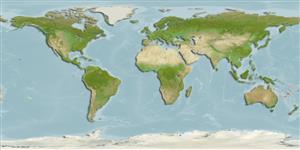>
Anguilliformes (Eels and morays) >
Chlopsidae (False morays)
Etymology: Chlopsis: Greek, chloea = green + Greek, opsis = appearance (Ref. 45335); bidentatus: From the Latin bi for two and dentatus for toothed, referring to its distinctive vomerine dentition (Ref. 47953).
More on authors: Tighe & McCosker.
Environment: milieu / climate zone / depth range / distribution range
Ekologi
marina djupbottenlevande; djupintervall 300 - 503 m (Ref. 47953). Deep-water
Western Central Pacific: New Caledonia and Fiji.
Size / Vikt / Age
Maturity: Lm ? range ? - ? cm
Max length : 16.7 cm TL hane/ej könsbestämd; (Ref. 47953)
Short description
Bestämningsnycklar | Morfologi | Morfometri
Ryggkotor: 125 - 128. Bicolored pigmentation, light brown above and distinctly white ventrally; dorsal origin about one-eye diameter behind gill opening; vomerine dentition in two biserial rows anteriorly (Ref. 47953).
Life cycle and mating behavior
Könsmognad | Reproduktion | Lek | Ägg | Fecundity | Larver
Tighe, K.A. and J.E. McCosker, 2003. Two new species of the genus Chlopsis (Teleostei: Anguilliformes: Chlopsidae) from the southwestern Pacific. Zootaxa 236:1-8. (Ref. 47953)
IUCN Red List Status (Ref. 130435: Version 2024-1)
Threat to humans
Harmless
Human uses
Verktyg
Special reports
Download XML
Internet-källor
Estimates based on models
Preferred temperature (Ref.
123201): 8.3 - 17.2, mean 13 °C (based on 15 cells).
Phylogenetic diversity index (Ref.
82804): PD
50 = 0.5002 [Uniqueness, from 0.5 = low to 2.0 = high].
Bayesian length-weight: a=0.00102 (0.00046 - 0.00225), b=3.06 (2.88 - 3.24), in cm total length, based on all LWR estimates for this body shape (Ref.
93245).
Trofisk nivå (Ref.
69278): 3.7 ±0.6 se; based on size and trophs of closest relatives
Fishing Vulnerability (Ref.
59153): Low vulnerability (10 of 100).
